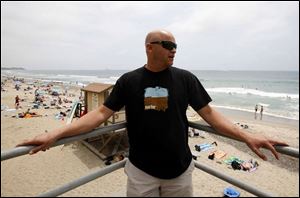
Rising cost of petroleum wipes out fun for surfers
7/18/2008
Chris Mauro has stopped taking a 10-mile detour to check out conditions at his favorite spot.
SAN CLEMENTE, Calif. - For years, Chris Mauro took a 10-mile detour on his way to work each morning to check out the swells at his favorite surfing spot in preparation for his after-work wave-riding.
But with gasoline approaching $5 a gallon, Mr. Mauro recently cut out his daily ritual.
The surging cost of oil has been a dose of reality for many surfers.
The industry depends on petroleum-based products to build and ship its boards. And surfers in search of the biggest waves have to dig deeper into the pockets to fill their gasoline tanks or book flights to the world's best waves, including places like South Africa and Tahiti.
"We all think about oil in our cars, but very few of us really consider the fact that every little piece of manmade equipment around you is oil-based, and surfing's no different," said Mr. Mauro.
Surfing has been one of the fastest growing sports industries in the nation.
In 2006, independent retailers of gear brought in $2.7 billion in revenue, up from $2.5 billion two years before.
Meanwhile, U.S. retail sales of surfboards jumped from $106 million in 2004 to more than $190 million in 2006, according to the Surf Industry Manufacturers Association.
Industry numbers for 2007-08 aren't yet available, but some retailers and manufacturers say they expect sales to slow after experiencing drops approaching 30 percent in their own operations.
Some predict family-run surfboard workshops - once the mainstay of the industry - will suffer more than the large national board makers.
The smaller operations are struggling with the rising cost of petroleum-based resin used to coat surfboards. They also are receiving fewer orders from mainstream retailers that tend to bypass regional board brands when times are tough.
U.S. bookings to exotic surf spots in Asia have dropped 20 percent as airfares soar as high as $2,500 to places such as Sumatra, said Sean Dunlap, sales manager at Wave Hunters, a specialty surf travel agency in San Diego.
Many airlines have added or increased excess luggage fees that can add hundreds of dollars to a ticket for surfers with board bags.
But some die-hard surfers are determined to enjoy their sport - expensive or not.
As the sun set over San Clemente's famed Trestles surf break on a recent summer day, Alan Harrison peeled off his wet suit and vow he would never choose money over surfing.
"If you love it, you can't change it for anybody or anything," said Mr. Harrison, 23, who spends $40 a week to get to Trestles from his inland home. "Even if gas went to $10 a gallon, I'd still do it. I'd find a way. It's an addiction."